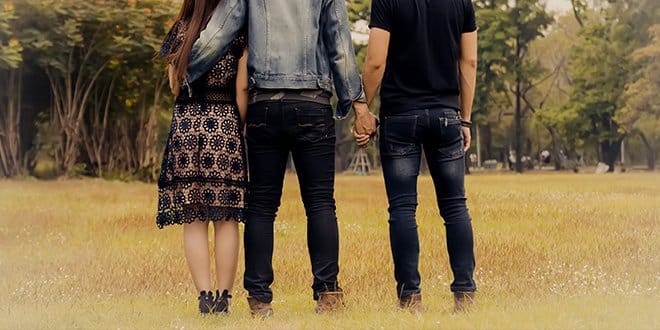What is Bisexuality?
While most folks feel like like they have a basic understanding of being bi – it means liking men and women both, right? – the current definition is a little different. ‘Bi’ means two, but most people define what those ‘two’ things are as ‘both like and unlike’ genders. It make sense if you think of ‘hetero’ as meaning ‘unlike’ and ‘homo’ as meaning ‘like,’ and includes people who are non-binary (identify as neither male or female).
What is Pansexuality?
The recent coming out of the fabulous Janelle Monae as pansexual left a lot of ladies extremely happy – and some people quite confused. What exactly is pansexuality – and isn’t it just a dressed up synonym for bisexuality?
Nope! Pansexuality means an attraction to all gender, but regardless of gender. An easy way to think of it is the slogan “Hearts, Not Parts’ – as in, pansexual people are attracted to people without any consideration of their gender; it doesn’t factor into their attraction at all.
How Can I Support My Pansexual Pals & Bisexual Buddies?
Both pansexual and bisexual people can get a lot of grief – both from the straight and the LGBT community, which is perhaps why they come out less than their gay and lesbian counterparts, – despite being a majority in the community. Bi and pan men uniquely face a stigma, with only 12% saying they are out to everyone in their lives, compared to the (still low compared to gay and lesbian) 28% of bi people overall who are out.*
Sometimes supporting your LGBTQ friends is as easy as being a good friend to anyone – you’re there to share fun times together, celebrate good times and commiserate over every annoying boss or awful breakup. But here are some specific things your bi or pan friend is probably tired of hearing:
- That they’re ‘faking it’ for attention or are ‘really gay/straight’ and can’t make up their mind: Considering the sort of negative attention garnered by these orientations, it doesn’t really make sense that anyone would look for it actively. And, while it can be hard for monosexual people to envision, there’s doesn’t need to be a choice for dating one type of person – unless we just didn’t see that box on our ‘how to be a happy, sexually-fulfilled adult’ application form.
- That they must non-monogamous or likely to cheat: There are bisexual and pansexual people who are in open relationships, and who cheat – just as there are some straight and gay people who do the same – it’s not a prerequisite.
- That if they haven’t had experience with someone of the same/opposite gender, they can’t ‘really’ be bi or pan: While some people might find, upon acting on an attraction to someone, that they aren’t as interested in that gender as they thought, that certainly isn’t the case for everyone. Afterall, no one asks straight people ‘how they could really know they were straight’ before they began having sexual activity. And, of course, you can be asexual while bi or panromantic!
- That they’re ‘straight’ when they’re in an opposite gender relationship or gay when they’re not: Being in a relationship isn’t a magical potion that changes someone’s orientation; you’re still bi and pan whatever the type of relationship you’re in, and when you’re single.
- That ‘their same-gender’ relationships don’t count or aren’t relatable: This is a unique type of treatment that often comes from well-meaning and otherwise accepting friends and partners. If you’re cool with your girlfriend, for example, having sex with other women but not other men, think about whether that means you don’t really view this relations as important or ‘counting’ as much as ‘heterosexual’ hookups. If you love dishing about bad dates and exciting crushes with a friend, but become uncomfortable when they talk about dating someone of the same gender, they are definitely picking up on that.
And a Reminder About the LGBTQ Friends You Didn’t Know You Have
Don’t think you have any bisexual or pan friends? It’s possible you do and just don’t know it! There are a lot of reasons people might not be out – either to themselves or everyone in their lives. For example, only 20 states in the US have laws preventing anyone from being fired based on their sexual orientation or gender identity.**
Keeping this in mind, how you talk about people who are LGBTQ might be hitting home for your friends in family in ways you don’t – 6 in 10 LGBTQ Americans say they have been told jokes or heard slurs based on their orientation.***
Conclusion
We hope this basic definitions of what bisexuality and pansexuality are helped you feel a little more informed, and maybe even a little more prepared to be a better loved one to a bi or pan partner, friend or family member who might be figuring out their identity – or even yourself!
*http://www.pewresearch.org/fact-tank/2015/02/20/among-lgbt-americans-bisexuals-stand-out-when-it-comes-to-identity-acceptance/
**https://www.fastcompany.com/40456937/heres-everywhere-in-the-u-s-you-can-still-get-fired-for-being-gay-or-trans
***https://www.cbsnews.com/news/gay-lesbian-bisexual-transgender-survey-finds-nearly-4-in-10-rejected-by-family-or-friend/
[related_article id=”17051″ float=”right” size=”full” target=”_blank”]

